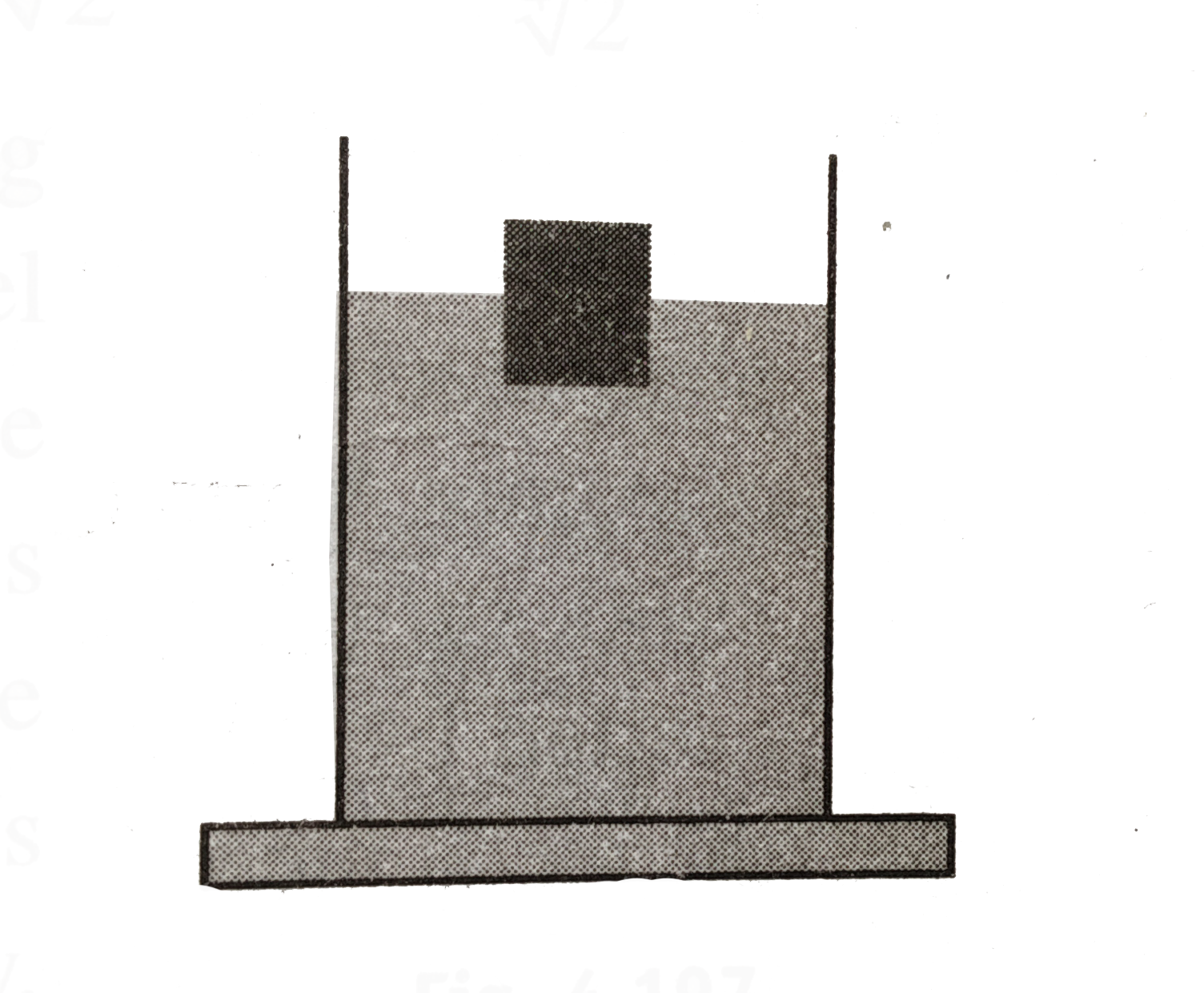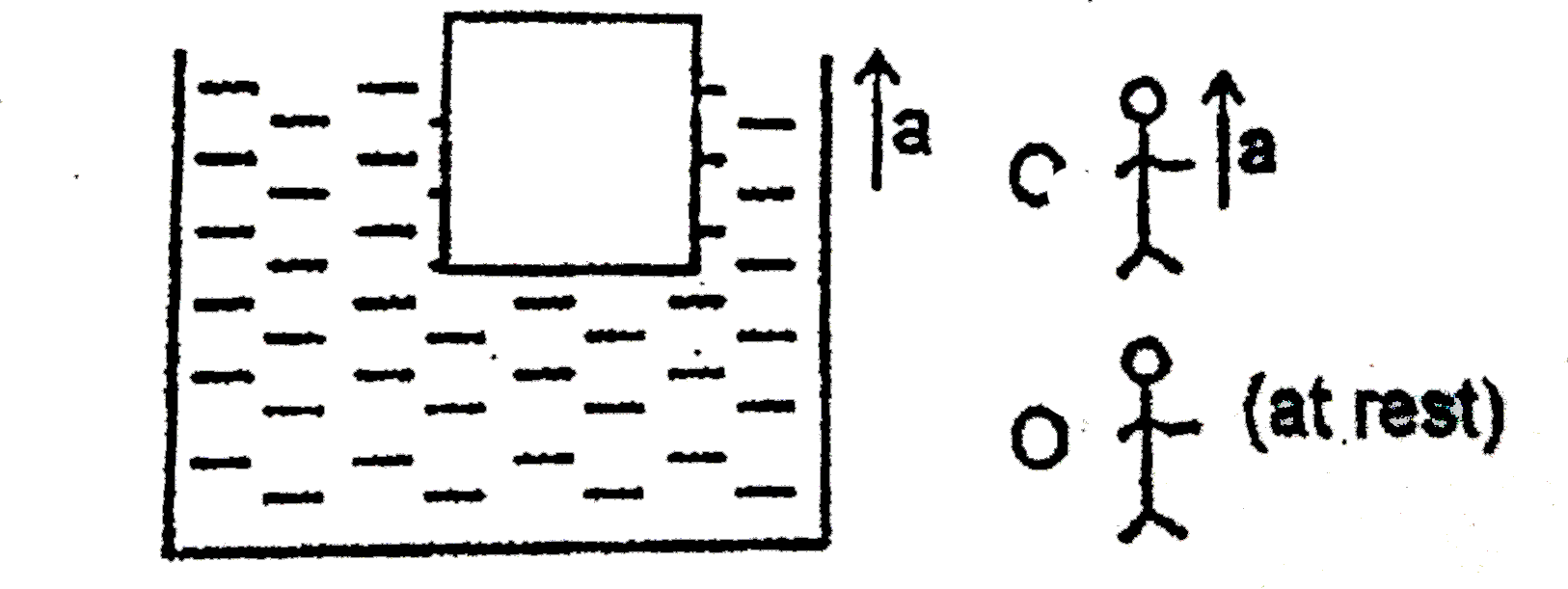A cylindrical block is floating (partially submerged) in a vessel containing water. Initially, the platform on which the vessel is mounted is at rest. Now the platform along with the vessel is allowed to fall freely under gravity. As a result, the buoyancy force

becomes zero
decreases
increases
information is insufficient
The correct Answer is:A
As the vessel is falling freely, the pressure at all the points in the liqids is same and equal to the atmospheric pressure and hence buoyancy becmes zero.
Topper's Solved these Questions
- BOOK - CENGAGE PHYSICSCHAPTER - FLUID MECHANICSEXERCISE - Multipe Correct15videos
FLUID MECHANICS
- BOOK - CENGAGE PHYSICSCHAPTER - FLUID MECHANICSEXERCISE - Assertion-Reasoning8videos
FLUID MECHANICS
- BOOK - CENGAGE PHYSICSCHAPTER - FLUID MECHANICSEXERCISE - Subjective25videos
FLUID MECHANICS
- BOOK - CENGAGE PHYSICSCHAPTER - DIMENSIONS & MEASUREMENTEXERCISE - Integer2videos
DIMENSIONS & MEASUREMENT
- BOOK - CENGAGE PHYSICSCHAPTER - GRAVITATIONEXERCISE - INTEGER_TYPE1videos
GRAVITATION
Similar Questions
A block is fully submerged in a vessel filled with water by a spring attached to the bottom of the vessel. In equilibrium position spring is compressed. If the vessel now moves downwards with an acceleration a(<g). What happens to the length of the spring.?
 View Solution
View SolutionA block of ice with a lead shot embedded in it is floating on water contained in a vessel. The temperature of the system is maintained at 0∘C as the ice melts. When the ice melts completely the level of water in the vessel rises.
View Solution
Knowledge Check
- Question 1 - Select One or More
The block shown in the figure is in equilibrium in a liquid and one end of the spring is connected to the base of the vessel. Now the vessel is made to fall freely under gravity. The length of the spring from the equilibrium situation may:
 AIncreaseBDecreaseCRemains constantDdata insufficient
AIncreaseBDecreaseCRemains constantDdata insufficient - Question 2 - Select One
A stone is thrown upwards from the top of a tower with some initial speed and it reaches the ground in 16 seconds. Now it is thrown with the same initial speed downward and it reaches the ground in 9sec. In how much time will it reach the ground if the stone is allowed to fall freely under gravity from the same place ?
A25 sB12.5 sC7 sD12 s - Question 3 - Select One
A block is partially immeresed in a liquid and the vessel is accelerating upwards with an acceleration 'a'. The block is observed by two observers O1 and O2, one at rest and the other accelerating with an acceleration 'a' upward. The total buoyant force on the block is :
 Asame for O1 and O2Bgreater for O1 then O2Cgreater for O2 then O1Ddata is not sufficient
Asame for O1 and O2Bgreater for O1 then O2Cgreater for O2 then O1Ddata is not sufficient
Two identical cylindrical vessel with their bases at the same level each contain a liquid of density ρ. The height of the liquid in one vessel is h1 and in the other is h2 the area of either base is A. What is the work done by gravity is equalising the levels when the two vessels are connected?
View Solution(i) A cubical metal block of side 10cm is floating in a vessel contatining mercury. The vesel has a square cross section of side length 15cm. Water is poured into the vessel so that the metal block just gets submerged. Calculate the mass of water that was poured into the vessel. It is given that relative density of the metal and mercury are 7.3 and 13.6 respectively.
(ii) In the last question, in place of water if we poured another liquid of relative density 'r' it was found that when the metal block ws just completely submerged it was no longer touching mercury. what is value of r?View SolutionA small object is placed at the centre of the bottom of a cylindrical vessel of radius 3 cm and height 4 cm filled completely with water. Consider the ray leaving the vessel through a corner. Suppose this ray and the ray along the axis of the vessel are used to trace the image. Find the apparent depth of the image and the ratio of real depth to the apparent depth under the assumptions taken. Refractive index -of water = 1-33.
View Solution10 mole of liquid 'A' and 20 mole of liquid 'B' is mixed in a cylindrical vessel containing a piston arrangement. Initially a pressure of 2 atm is maintained on the solution. Now, the piston is raised slowely and isothermally. Assume ideal behaviour of solution and A and B are completely miscible.
P∘A=0.6 atm and P∘B=0.9 atm
The pressure at which 13 the of the total amount (by mol) of liquid solution taken initially will be present in the vapour form is [Given: √57=7.55]View Solution10 mole of liquid 'A' and 20 mole of liquid 'B' is mixed in a cylindrical vessel containing a piston arrangement. Initially a pressure of 2 atm is maintained on the solution. Now, the piston is raised slowely and isothermally. Assume ideal behaviour of solution and A and B are completely miscible.
P∘A=0.6 atm and P∘B=0.9 atm
The pressure below which the evaporation of liquid solution will start, isView Solution

